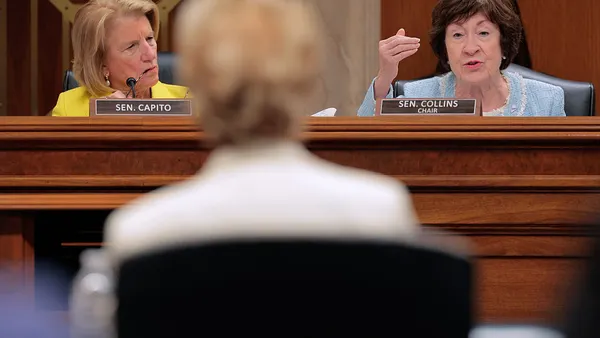Hoping to boost student performance in math at Shawnee Mission South High School in Kansas, Principal Todd Dain and his staff put together an intervention team at the start of the 2022-23 school year.
All students enrolled in Algebra I and Geometry I had both a math teacher and an intervention specialist in their classrooms. The extra support paid off when over 22% of the school's 1,600 students improved their math skills by an entire letter grade in the last school year, Dain said.
Dain gives credit for that success to his team’s creation of a 90-day plan outlining goals for the beginning of the school year. A staff member led the initiative to boost student math achievement by working with school leadership to map out how to start off and then how to monitor student progress by the end of September. The team also prepared for any potential adjustments needed in October.
“That’s something that we planned out from the beginning. Initially, we didn’t know how it was going to go,” Dain said. “It was really a 90-day plan that has been successful from the start with that, but we also wanted to make sure we were monitoring the progress moving forward.”
As school leaders like Dain prepare for a new school year, they are often gearing up to implement their own 90-day plans.
These plans will look different depending on the school or district, but typically the model outlines a road map for leaders to check in with staff on goals they hope to achieve within the first 90 days of the school year. Some districts require only new principals to create and enforce 90-day plans, while others integrate the planning model for all leaders — sometimes for the start of the school year, and sometimes on a repeating 90-day cycle throughout the school year.
According to Donna DeSiato, superintendent of East Syracuse Minoa Central School District in New York, the idea in her district came from the Plan-Do-Study-Act Cycle developed by scholar W. Edwards Deming to provide a continual improvement model for a product, process or service.
As a new academic year gets underway, we spoke with school and district leaders to learn more about why the 90-day planning model is a successful approach for school improvement.
Setting the tone
In Baltimore County Public Schools, all first-year principals must create a 90-day entry plan for the start of the school year. George Roberts, a leadership consultant for the district, works directly with those principals to develop their goals and road maps.
These plans help school leaders set the tone for instruction as well as a school’s culture and climate, Roberts said. “It gives them a reference guide to help them open the school and … make some changes where necessary.”
Laying out a 90-day plan can also help new principals establish goals to build foundational relationships with stakeholders including staff, community groups and elected officials, Roberts said.
The plans benefit educators, too. When teachers receive consistent feedback via the 90-day model, it creates a school culture that gives teachers more buy-in and ownership of their "craft" as they work toward the school’s universal goals, said Kimberly Winterbottom, principal at Marley Middle School in Maryland.
For school culture, a 90-day plan "drives the conversation,” Winterbottom said.
Gauge progress faster
With a 90-day plan, teachers are relying on other short-term goals and data points to measure success rather than waiting for end-of-year test scores, Winterbottom said.
“We all need feedback as the year is going to see if we’re on track for students to make progress instead of this one big test at the end,” Winterbottom said. “It really helps teachers drive their instruction, too, because if the kids aren’t making progress at that point then they need to do something different. Or if it’s working, they know that they can continue to do the same.”
Overall, Winterbottom said the continual 90-day model creates a feedback loop that helps schools reach their end goal while monitoring any success or challenges along the way.
The 90-day approach is also cost-effective, said DeSiato, whose district uses 90-day cycles to measure school improvement four times a school year.
The ongoing planning cycle “increases the way in which we’re using our resources, because we’re not waiting for too long of a period of time to know that the areas of what we’re implementing are actually effectively working.”
It actually achieves goals
DeSiato said the 90-day planning tool is an effective evidence-based practice rather than just a trend. East Syracuse Minoa Central School District has tapped into the framework for at least the past six years.
“It helps us to stay focused and on task and gather the data that’s needed in order to determine if the implementation of our plans are actually having an impact,” DeSiato said.
At Marley Middle School, Winterbottom said, 90-day planning has noticeably improved student achievement.
The school’s language arts department created an overall goal to reach student growth of 5-8% in testing performance last year. The school met that goal within 180 days, or two 90-day plans, when it reached 3% growth in the first cycle and added another 3% in the following 90-day period, according to Winterbottom.
The strategy can also go beyond setting and measuring goals in academics and track progress in other areas like improving mental health resources or increasing student engagement or participation, DeSiato said.
Tips to keep in mind
A good 90-day plan is succinct, though not necessarily short, Roberts said, and at the principal level should align with district goals and initiatives. “A bad one will be too broad, it will list too many goals, it will list too many ‘checklist to-do items,’” he said.
At the same time, Roberts said, it should contain solid mid- to long-range aspirations.
Accountability among school and district leaders is a huge component, too, Winterbottom said, and the model needs to be implemented with fidelity.
School leaders recommend breaking down the plan by departments to spread ownership of the goals staff leadership helped create.
They also suggest continually reevaluating goals — while understanding the plan should be fluid.
“The wrong way is to put something in place and not adapt it based off of the data,” Winterbottom said. “You can put this goal at the end of the year, and you can put these 90-day plans into place, but they can’t be stagnant. They have to be fluid. It has to be a living document that you’re constantly monitoring or looking at.”








 Dive Awards
Dive Awards








